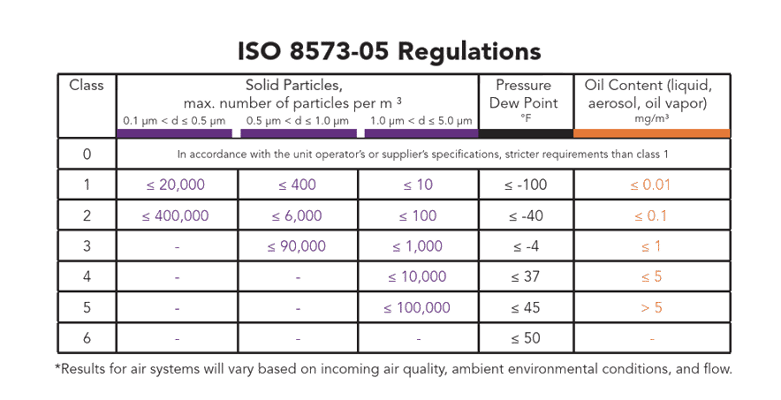Inline compressed air filters are vital for having clean air for your applications and pneumatic tools. However, it can be difficult when trying to decide. Understanding the contaminants in your air supply and which filter types can remove them is the first step in selecting the right inline air filter for your system.
In this article, we'll answer the following questions:
- How Does Compressed Air Become Contaminated?
- What are Inline Air Filters Used to Remove?
- How do Inline Air Filters Work?
- What is Considered Optimal Air Quality?
- Choosing the Right Inline Compressed Air Filter Setup for Your System
How does Compressed air become contaminated?
A poor air supply can be caused by multiple sources. For example, compressed air can become contaminated from dirty ambient air, humidity, oils leaking from the air compressor, corroded air lines, and even from the air filter itself. Understanding the contaminants and their origin is a good starting point for shops experiencing poor air.
The majority of the contaminants found in an air system are:
- Liquid water
- Water vapor (humidity)
- Oils
- Oil vapor
- Dust
- Dirt
- Aerosols
The dust and tiny particles in the ambient air around you are the same contaminants that can enter your system while it is running. Contaminants are different-sized microns and can cause varying kinds of damage depending on their form.
Compressed air can also become contaminated from oils within the air compressor, corroded air pipes, and poorly maintained air filters.
Compressed air filters pull out the bulky contaminants - like dust particles, particulates, oils, and liquid water - to prevent equipment damage and maintain air system performance.
What are inline air filters used to remove?
Inline air filters for air compressors effectively remove liquid water, oils, oil vapors, dust, dirt, aerosols and other bulky particulates. There are three types of air filters designed to remove certain contaminants:
- Water separators
- Oil Coalescing filters
- Activated Carbon Filters
1. Water Separators
Water separators are designed to remove large particulates and liquid water.
2. Oil Coalescing filters
Oil coalescing filters pull out oil vapors, small and fine particulates, and bulk oils from the air stream.
3. Activated Carbon filters
Activated carbon filters eliminate odors, tastes, and remove aerosols from the air flow.
How do inline Air filters work?
Each of the three filters - oil coalescing, water separators, and activated carbon - are designed to target specific kinds of contaminants. To get the clean, dry air needed for your application it may require one, two, or even three air filters. This is dependent on which contaminants should be filtered out for your system to work the way it's intended.
These filters work by removing contaminants at a specific micron size: microns are particles that cannot be seen by the human eye. Depending on the amount of air filters installed on a system, the contaminants of different micron sizes filtered out can help the air become clean and dry, or just clean. There are ISO regulations that detail the class, particle sizes, and the pressure they can withstand. This is important to refer to when choosing the right compressed air filter for you.
What is considered optimal air quality?
Air quality requirements are different for every system. There isn't a one-size-fits-all solution when it comes to filtration for equipment - air quality requirements are different for every system. The way to find the filtration required for your air compressor system, is by reading the fine print on the machine and consider the application it is being used for.
There's also a set of standard ISO 8573-05 regulations required for some industries.

It's important to know the filtration needed for specific air systems so they operate at their highest efficiency and do not dysfunction prematurely from not having the right inline air filter.
Download our air system schematic to understand how each air filter pulls out contaminants and how they pair with the most common air dryers.
choosing the right Inline Compressed Air Filter setup for your system
There are a few considerations to make before purchasing an inline compressed air filter package:
- The specific air requirements for your machine or application
- The ISO requirements of your system or industry
- The desired outcome of the product or process
- Other air treatments in place, such as drains, dryers and other filters
We recommend some initial investigation of your compressed air needs and cleanliness goals. Here's a guided checklist to get started on selecting the right inline compressed air filter:
- Refer to the list above to determine the air cleanliness goals and needs for your system.
- From there, determine the air demand of your system (10 CFM, 25 CFM , 50 CFM etc..) so the filters can be sized properly. Note: Purchasing larger filters does not mean cleaner air, they will only add cost to your operations.
- Finally, make sure to choose an air filter that is of higher quality and fits your maintenance schedule. Investing in cheaper products will only add headaches to your operations as they need to be replaced more often.
%20WEB.png?width=500&height=333&name=21999-0257%20(2022)%20WEB.png)
Ensuring Optimal Performance with the Right Inline Compressed Air Filter
Selecting the right inline compressed air filter is a crucial step towards ensuring the efficiency and longevity of your pneumatic tools and applications. As we’ve explored, understanding the variety of contaminants in your air supply and the specific requirements of your system is fundamental. Inline air filters, ranging from water separators to oil coalescing filters and activated carbon filters, each play a distinct role in purifying your air supply.
Remember, the key to achieving optimal air quality lies not just in selecting the right filter type, but also in considering factors such as your system’s specific air requirements, ISO standards, and the desired outcome of your product or process. It’s not a one-size-fits-all situation; each system requires a unique combination of filters to meet its specific needs.
In conclusion, we recommend conducting a thorough assessment of your compressed air needs and cleanliness goals, followed by consulting with a compressed air professional. This approach ensures that you invest in a high-quality, appropriately sized filter setup that aligns with your maintenance schedule, leading to enhanced system performance and reduced operational costs.
Ready to get started? Contact a compressed air professional to assist in designing the optimal air filtering system for you.



